R F Technologies SEEK01 RFID Tag User Manual Seeker Front Page
R F Technologies Inc RFID Tag Seeker Front Page
Contents
- 1. Users Manual
- 2. User Manual
Users Manual

Mobile Locating System
User Manual
P/N: 3100-0000-000
5Released: 01/06/0

Table of Contents
System Overview................................................................................................. 4
System Components ............................................................................................ 5
Tags................................................................................................................. 5
Receiver Card.................................................................................................. 5
Pocket PC........................................................................................................ 5
Software.......................................................................................................... 5
Installing Software............................................................................................... 6
Installing Receiver Card ...................................................................................... 6
Mounting Tags..................................................................................................... 7
Starting the Application ....................................................................................... 8
Main Window ...................................................................................................... 9
Performing Finds ............................................................................................... 10
Online / Offline ............................................................................................. 10
Selecting a Find............................................................................................. 11
Find Results................................................................................................... 12
Viewing Tag Details ..................................................................................... 13
Viewing History................................................................................................. 14
Programming Tags............................................................................................. 15
Tag Entry ........................................................................................................... 16
Add Tags....................................................................................................... 16
Edit Tags ....................................................................................................... 17
Delete Tags ................................................................................................... 17
Integrating with Mobile Resource Manager ...................................................... 18
Services Settings ........................................................................................... 18
Downloading................................................................................................. 19
Uploading...................................................................................................... 20
Additional Settings ............................................................................................ 21
System Information............................................................................................ 22
Frequently Asked Questions.............................................................................. 23
Specifications..................................................................................................... 25
Mobile Reader............................................................................................... 25
Tag ................................................................................................................ 25
Service and Repair............................................................................................. 26
Warranty ............................................................................................................ 27
2

Federal Communication Commission (FCC) Compliance
This device complies with Part 15 of the FCC Rules. Operation is
subject to the following two conditions: (1) this device may not cause
harmful interference, and (2) this device must accept any interference
received, including interference that may cause undesired operation.
This equipment generates, uses, and can radiate radio frequency energy and, if
not installed and used in accordance with the instruction manual, may cause
harmful interference to radio communications. Operation of this equipment in a
residential area is likely to cause harmful interference in which case the user will
be required to correct the interference at his own expense. Changes or
modifications not expressly approved by the party responsible for compliance
voids the user's authority to operate the equipment.
FCC ID: KXU-SEEK01
FCC Radiation Exposure Statement
This equipment complies with FCC radiation exposure limits set forth for an
uncontrolled environment. This equipment should be installed and operated with
minimal distance 20cm between the radiator and your body. This transmitter
must not be co-located or operating in conjunction with any other antenna or
transmitter.
3
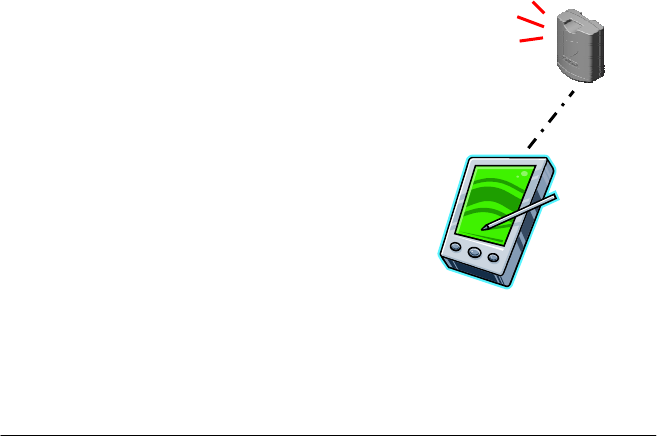
System Overview
The Seeker Mobile Locating System is an asset tracking system utilizing a mobile
reader to allow remote reading of RFID tags. The Seeker mobile reader consists of
a Pocket PC with a custom receiver card installed. The mobile reader is used to
"search" an area for "tags" which are attached to various resources. The reader can
find an individual tag, or search for all tags with a specific department id. When a
tag is within range of the mobile reader an audible beep and light can be generated
by the tag so a user can locate the equipment within the area being searched. The
beep and light features can be disabled if desired.
A local database in the mobile reader creates associations between the resources
and the tags. When a tag is found the mobile reader will display the department id,
tag id, resource name, description and the signal strength which provides an
estimated distance from reader to tag. A picture of the resource can also be
associated with the tag information.
The Seeker Mobile Locating System can be combined with the PinPoint Mobile
Resource Manager software to provide extended visibility to the data captured
through the reader. Information from the mobile reader can be uploaded to the
PinPoint databases and then viewed by PinPoint applications. Additionally,
utilization and location reports can be generated using captured data from the
mobile reader.
Uses for the System:
Locate misplaced equipment
Remotely identify inventory
Find equipment scheduled for maintenance
Remote inventory of valuable assets
Special Features:
User-programmable RFID tags
Compact size
0-100ft range through walls, up to 500ft in "clear air"
Tag beeper and light helps physically locate equipment
Down-loadable data to host using sync cradle
4
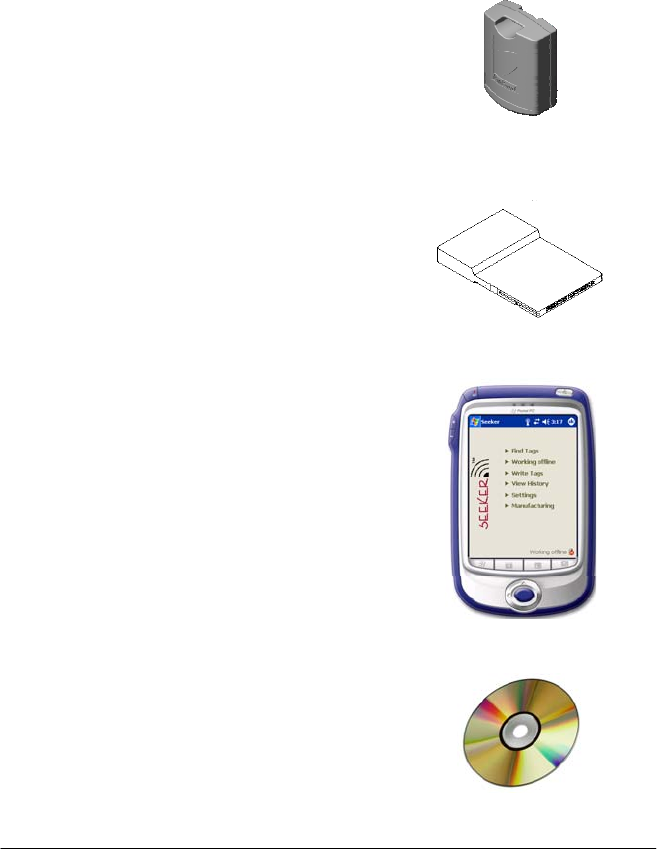
System Components
Tags
Tags are small in size and can be attached to
resources using the included adhesive tape.
When a tag is found by the mobile reader it
responds with its unique id and a status
message indicating its battery condition.
Tags can be instructed to beep and flash a
light when found allowing users to gain a
rough indication of where the tag is located.
Receiver Card
The CompactFlash receiver card includes the
receiver circuitry and the microprocessor for
decoding the tag signals to obtain the
department id, tag id and the status of the tag.
The information is then transferred to the
Pocket PC.
Pocket PC
The Personal Digital Assistant (PDA)
includes the Microsoft Pocket PC Operating
System. The PDA supports the
CompactFlash standard CF+/Type II for the
addition of the receiver card.
Software
The software and documentation are provided
on a CD-ROM.
5
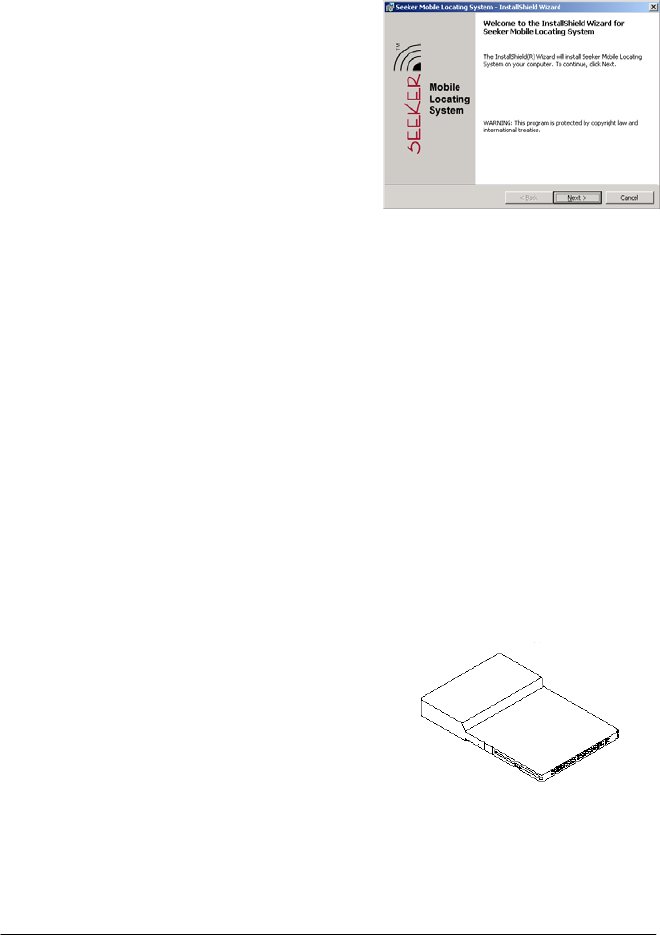
Installing Software
To install the Seeker application on your
Pocket PC from the software and
documentation CD:
1. Using your sync cable or cradle,
connect your Pocket PC to the
computer. For additional
information, see the documentation
that came with your Pocket PC.
2. Insert the software and
documentation CD into the drive on
the computer.
3. Using Microsoft Windows Explorer
or My Computer, navigate to x:\,
where x is the CD drive letter.
4. Double-click setup.exe.
5. Follow the instruction on the
computer screen to finish the
installation.
The Seeker application will be uploaded to
the Pocket PC through the sync cradle.
Installing Receiver Card
Insert the Receiver card into the compact
flash slot on the Pocket PC. Be sure the card
is seated properly in the compact flash
connector.
The Receiver Card does not require a custom
driver and should communicate directly with
the Seeker application.
The Receiver Card includes an LED to
indicate power and data arriving from the
Pocket PC.
Windows Installation
Software
Receiver Card
6
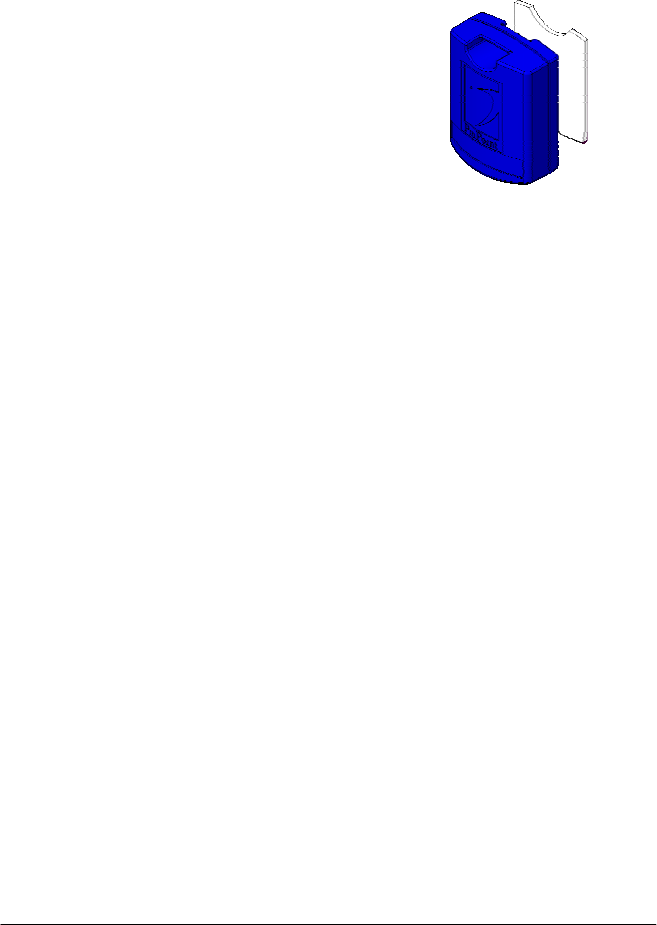
Mounting Tags
The Seeker Tag can be attached using an
adhesive pad that can be purchased with the
tag. The following section provides detailed
steps about applying the tag using the
adhesive.
To apply the adhesive pad to the tag:
1. Remove an adhesive pad from the
strip of paper.
2. Turn the tag onto its front.
3. Line the adhesive pad up with the
back of the tag.
4. Apply the adhesive pad.
5. Verify that the pad is applied
correctly and is not hanging over the
sides of the tag.
To attach a tag to a resource using an
adhesive pad:
1. Obtain the asset to which you want
to apply the tag.
2. Remove the adhesive plastic guard.
3. Firmly attach the tag to the asset.
4. Press firmly on the tag to verify that
it adhered to the asset
• Notes
• Before installing the tags make sure to
program them to the correct department
and tag ids. See the section
Programming Tags for further details.
• You may also use other means of
attaching a tag to your resources. For
example, a loop mount zip tie.
Tag Adhesive
7
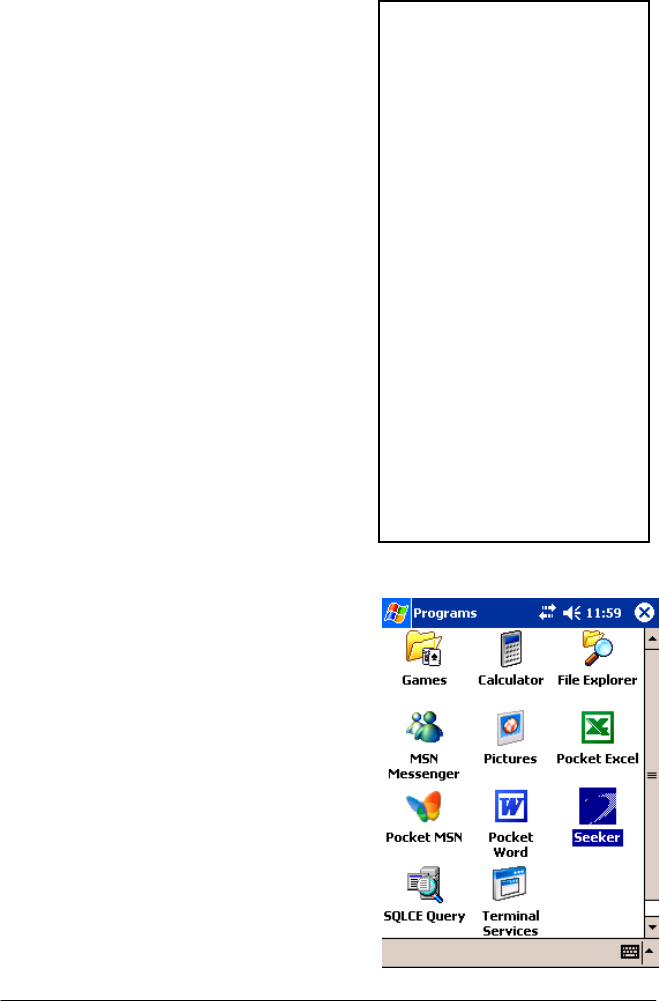
Starting the Application
To start the Seeker application:
1. Tap Start->Programs->Seeker
If this is the first time the application has
been run on this Pocket PC the local SQL CE
databases will be created. A progress bar will
be displayed during the creation of the
database and tables.
Once the database and tables have been
created the Seeker Main window will appear.
During start-up the application will search for
the receiver card and select the appropriate
communication port for its operation. If the
card can not be found it may be necessary to
use the Settings window to select and try
each of the available communication ports
until the correct one is found.
Mounting Suggestions:
• The front of the tag
should face the expected
position from which
searches will be
performed.
• Do not place the tag
inside of a metal
container as the signal
will be blocked.
• Perform a test for tag
reception by performing
a search after mounting.
• Do not block the sounder
hole or tag volume will
be decreased.
• Try to make the tags
light visible when
mounting on the
resource.
8
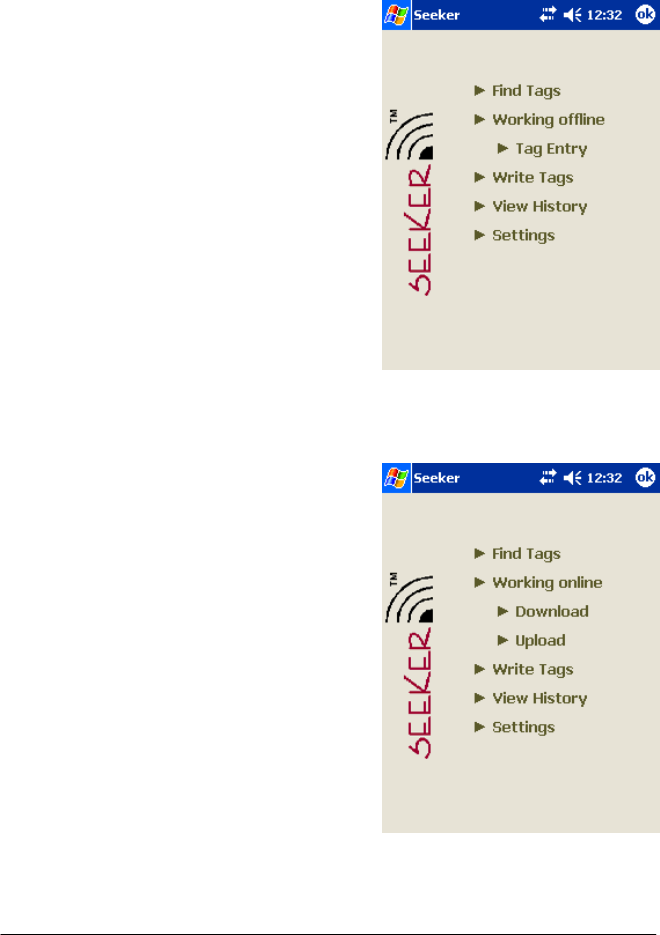
Main Window
This window is the main navigation area.
Find Tags – Window to select department
and tag ids or resource name to search for.
Work Online/Offline – Determines if the
mode of operation for the application.
Write Tags – Writes and erases the dept and
tag ids in a tag.
View History – Records of each find are
stored in the Pocket PC. This utility is used
to review these archival records.
Settings – Changes settings such as
threshold, ruleset selection, clearing the
history, and exporting the history to a CSV
file.
• Notes
• In the offline mode the Tag Entry
selection is made available. The Tag
Entry window makes the association
between a tag and its resource.
• In the online mode two additional
selections will appear: Download and
Upload. These selections assist in
staying synchronized with a PinPoint
Mobile Resource Manager software
system.
Main Window Offline
Main Window Online
9
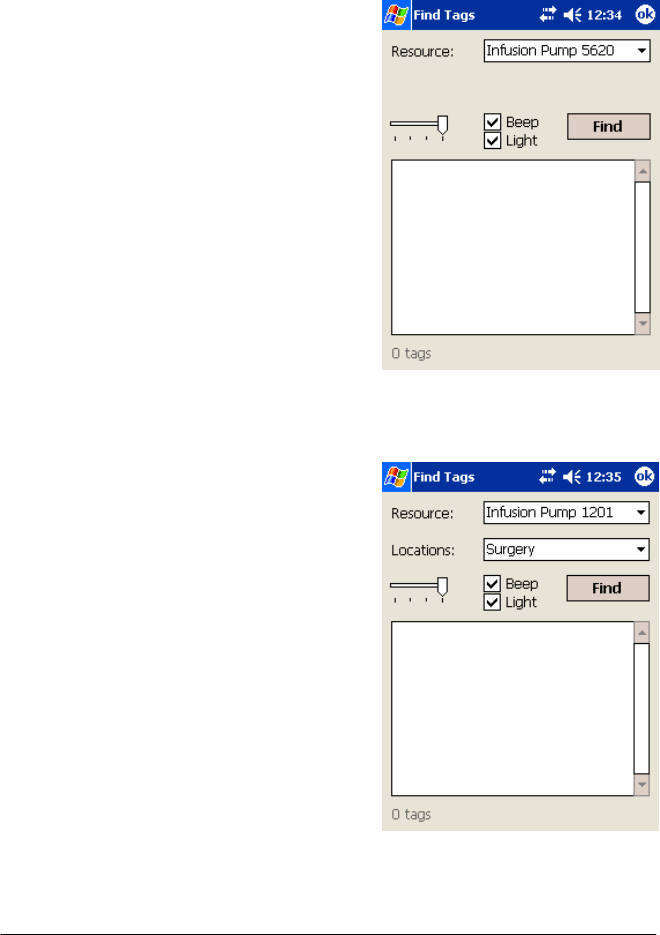
Performing Finds
Online / Offline
The Find Tags window can appear in one of
three modes.
Working offline using Resource Names
The user must select a resource to search for
by selecting its resource name from Resource
box. Department searches can not be
performed when using the resource names.
To operate in this mode select the Use
Resource Names checkbox in the Settings
window.
Working online using PinPoint Data
The user selects the location they are
currently occupying and the tag to find.
When tags are received they are matched to a
record in the local database. The database
information is used to provide additional
details about the tag and asset. Department
searches can not be performed when working
online.
Working offline using Dept and Tag
The user must select a department and a tag.
In offline mode the user can select a
department and then “any” tag or a specific
tag in the tag combo.
• Notes
• In online mode the locations and
resources are retrieved from the
PinPoint Mobile Resource Manager.
Consult the section Integrating with
Mobile Resource Manager for details.
Find Tags Offline using
Resource Names
Find Tags Online using
PinPoint Data
10
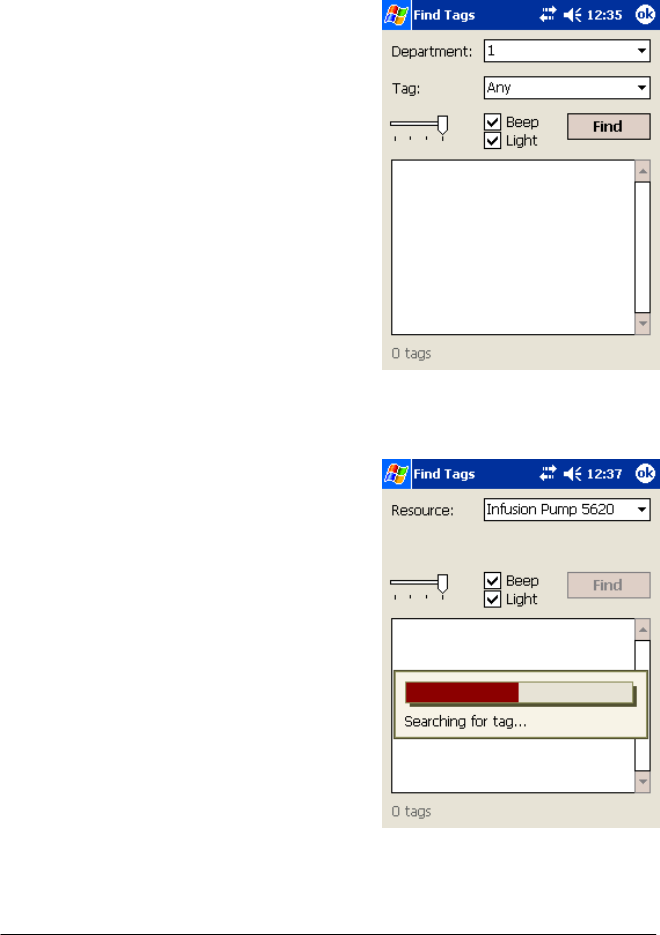
Selecting a Find
In offline mode the user can select a
department and then “any” or a specific tag in
the Tag box.
To find a tag:
1. In the Department box, select a
department id.
2. In the Tag box, select a tag id.
3. Select the Beep check box, to hear
the tag beep. Select the Light check
box to see the tag flash.
4. Move the Power Output slider to
the right to increase the output
range.
5. Click Find to start searching for
tags.
During the search a progress bar will be
displayed. The tag count in the lower left
corner will be incremented as tags are
received. Once all the tags are received the
progress bar will indicate “Complete” and the
tag list will be filled with the tags received.
• Notes
• Adjusting the Power Output increases
and decreases the range at which tags
will respond. A lower output setting
will decrease the number of tags that
respond to a find.
• When using resource names select the
resource name from the Resource box
then click Find.
• Only one mobile reader at a time
should perform a search.
Find Tags Offline using
Department and Tag ID
Progress Bar During Search
11
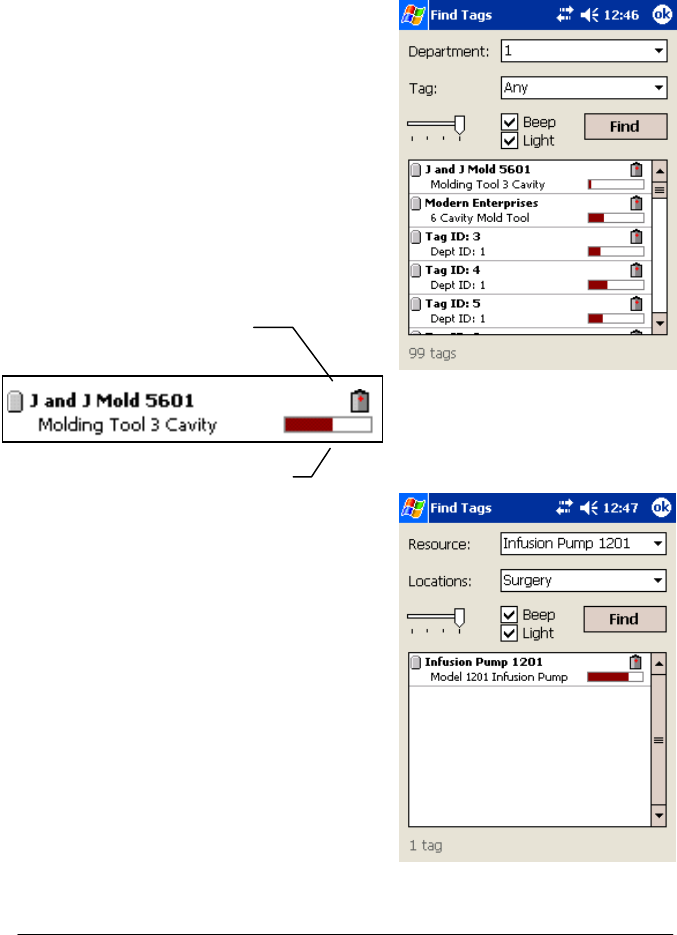
Find Results
Each tag received is displayed with its tag id,
dept id, battery status and the radio signal
strength indication (RSSI) at which it was
received.
The RSSI indicates a relative distance from
the reader.
If the tag has a low battery an icon will
appear above the signal strength bar.
Each entry can be interpreted as follows:
• Notes
• If a resource name and description is
available the first line of the tag list
entry will contain the resource name
and the second line will contain the
description of the resource.
• Selecting a tag in the tag list displays
further details about the tag.
Find Tags Offline using
Department and Tag ID
Find Tags Online using
PinPoint Data
Low Battery Indicato
r
Radio Signal Strength Indicato
r
12
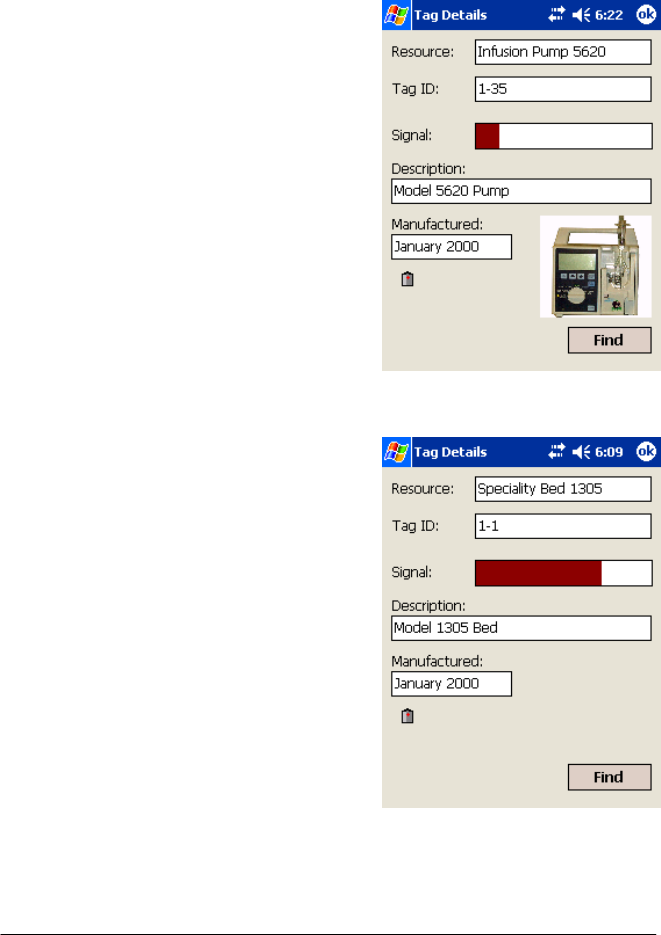
Viewing Tag Details
Selecting a tag in the list displays the Tag
Details window.
The Tag Details window provides additional
information about the tag and allows the
specific tag to be found again.
In offline mode the tag id, department id,
manufacturing date, low battery status, and
the signal strength are displayed. If available
the resource name, description, and resource
image will be displayed.
In online mode the tag id, resource,
manufacturing date, low battery status, signal
strength and description are displayed. The
resource and description come from the
database.
To further determine a tags location:
1. Click Find to search for this specific
tag.
2. The RSSI bar graph will be updated
with a new signal strength value.
3. The tag will beep and light based on
the checkbox selections from the
previous find.
• Notes
• If the tag is not found again during a
Find the signal strength bar will turn
light gray.
Tag Details Offline
Tag Details Online
13
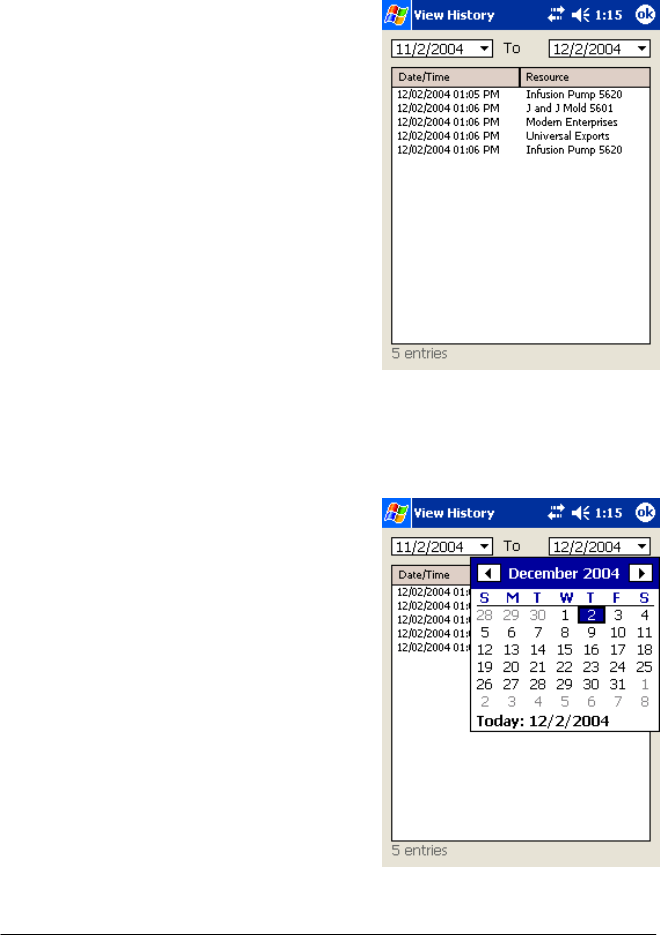
Viewing History
Each time a tag is received a record is created
in the History table in the SQL CE Server
Seeker database. The historical records can
be viewed through the View History screen.
Each record is presented with a timestamp of
when the tag was found and the resource
name or department/tag id.
The historical records can be filtered using
the Date Time Picker. Sequences of records
from a start to an end date can be displayed.
To select a start and end date:
1. Click Start Date arrow to display
the Date Picker.
2. Select Start Date from the Date
Picker.
3. Click End Date arrow to display a
second Date Picker.
4. Select End Date from the Date
Picker.
5. History List will update with the
new range of values.
6. The number of records returned by
the date range is displayed in the
lower left corner.
• Notes
• View History window defaults to
today’s date for both start and end.
• If searches become to slow the current
history table can be cleared from the
Settings window.
• The resource name will be displayed if
it was available.
View History
Selecting a Date Range
14
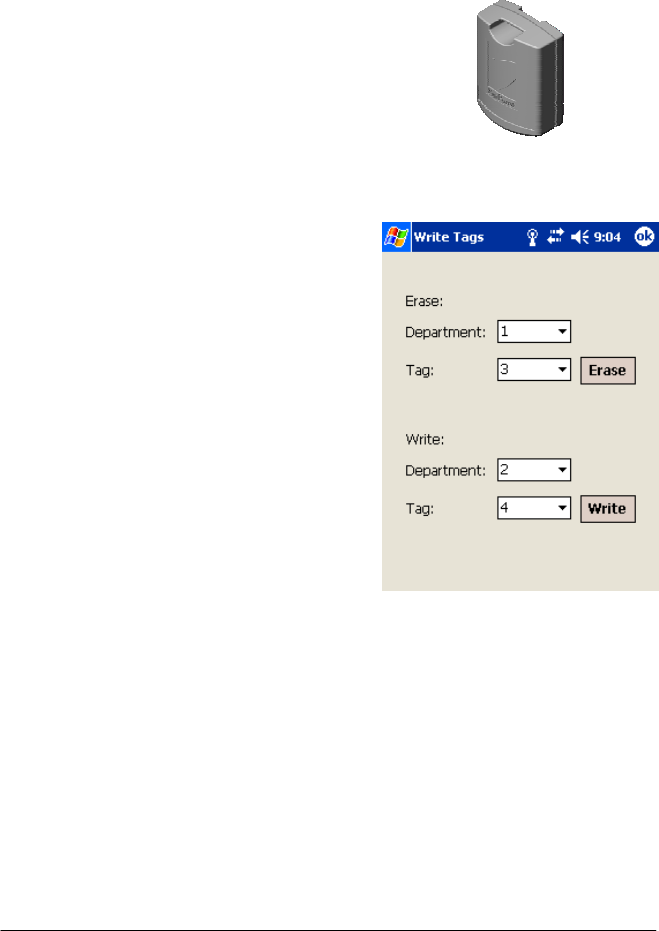
Programming Tags
To assist in categorizing assets and
performing efficient searches the tags can be
grouped by programming a department id
into each tag.
A tag must be blank before a new department
and tag id can be programmed into them.
Any tag that is blank and receives the write
message will have the new ids set into them.
To erase a tag:
1. In the Department box, select a
department id.
2. In the Tag box, select a tag id.
3. Click Erase.
4. Tag should beep indicating it has
been erased.
To write to a blank tag:
1. In the Department box, select a new
department id.
2. In the Tag box, select a new tag id.
3. Click Write.
4. Tag should beep indicating it has
accepted the new values.
• Notes
• Be sure to affix a label to the tag
indicating its new department and tag
ids.
• The initial id of a tag can be
determined by looking at the serial
number label.
• Be careful not to program two tags with
the same department and tag id.
Write/Erase Tags
15
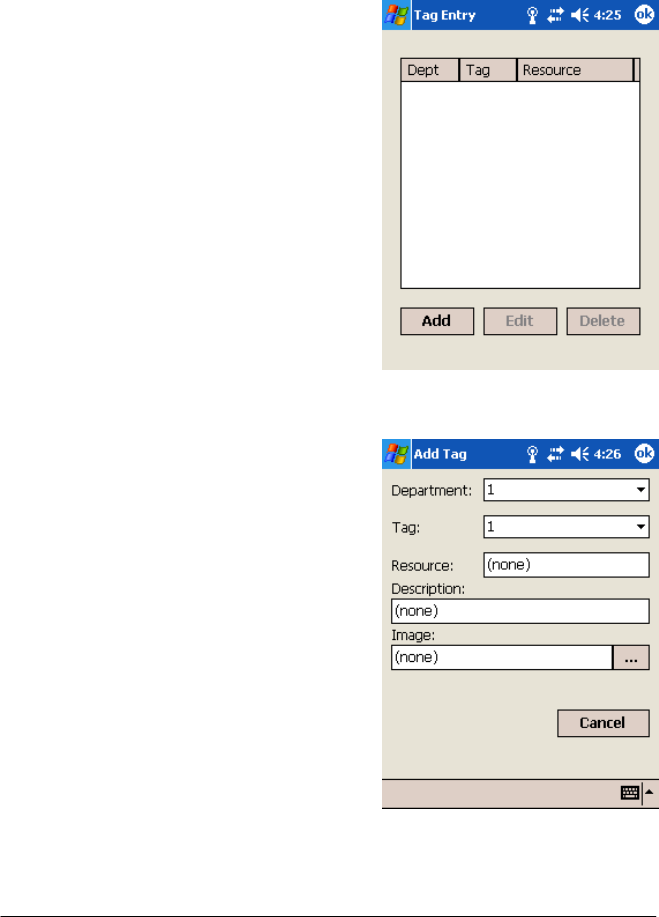
Tag Entry
Add Tags
It is much easier to search for a resource if we
can associate it with its attached tag. The Tag
Entry window performs the association
between the tag and its resource.
To associate a tag with a resource:
1. Click Add. The Add Tag window
will appear.
2. In the Department box, select a
department id.
3. In the Tag box, select a tag id.
4. In the Resource box, type the name
for this resource.
5. In the Description box, type a
description for this resource.
6. Click … to open the Save Dialog
window.
7. Select the bitmap to be used to
represent the resource.
8. Click OK, to save the tag
association.
Tag Entry
Add Tag
16
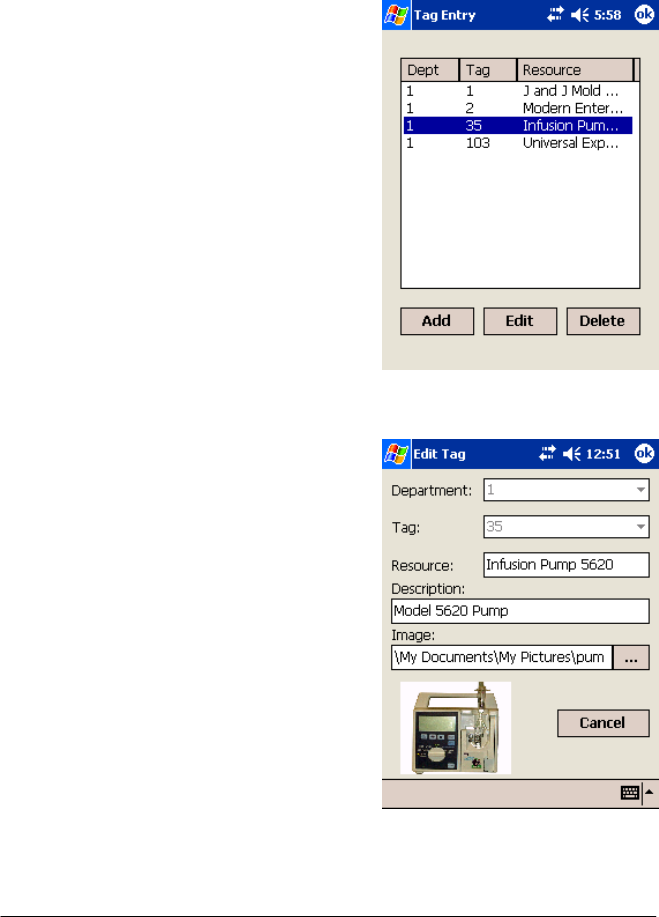
Edit Tags
It is much easier to search for a resource if we
can associate it with its attached tag. The Tag
Entry window performs the association
between the tag and its resource.
To associate a tag with a resource:
1. In the Tag Entry list, select an item
to edit.
2. Click Edit. The Edit Tag window
will appear.
3. In the Resource box, type the name
for this resource.
4. In the Description box, type a
description for this resource.
5. Click … to open the Save Dialog
window.
6. Select the bitmap to be used to
represent the resource.
7. Click OK, to save the tag
association.
Delete Tags
To delete a tag resource association:
1. In the Tag Entry list, select an item
to delete.
2. Click Delete. The item will
disappear from the list.
Tag Entry
Edit Tag
17
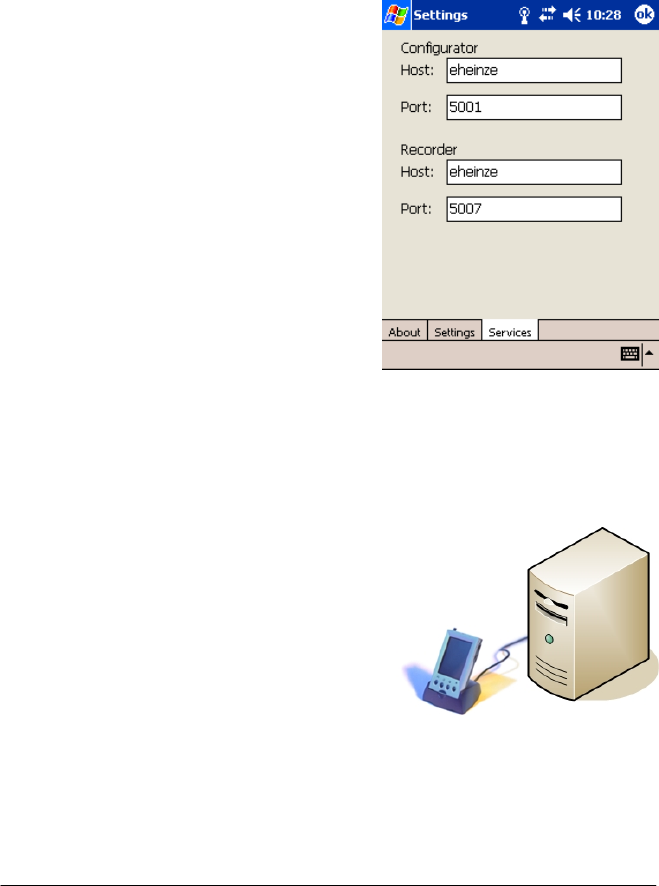
Integrating with Mobile
Resource Manager
Services Settings
The PinPoint Services are required when
integrating with the database. The settings
Services tab allows the user to configure the
host name and port for the PinPoint Services.
A network connection is created when the
Pocket PC is placed in the sync cradle. When
download or upload is selected from the main
window the Pocket PC communicates
through the network connection and retrieves
the SQL Server tables.
To find the correct Configurator and Recorder
host names and port see your PinPoint
Administrator.
To enter a host name and port:
1. In the Host box, type the machine
name of the computer hosting the
service.
2. In the Port box, type the port
number used by the service.
Settings Services
18
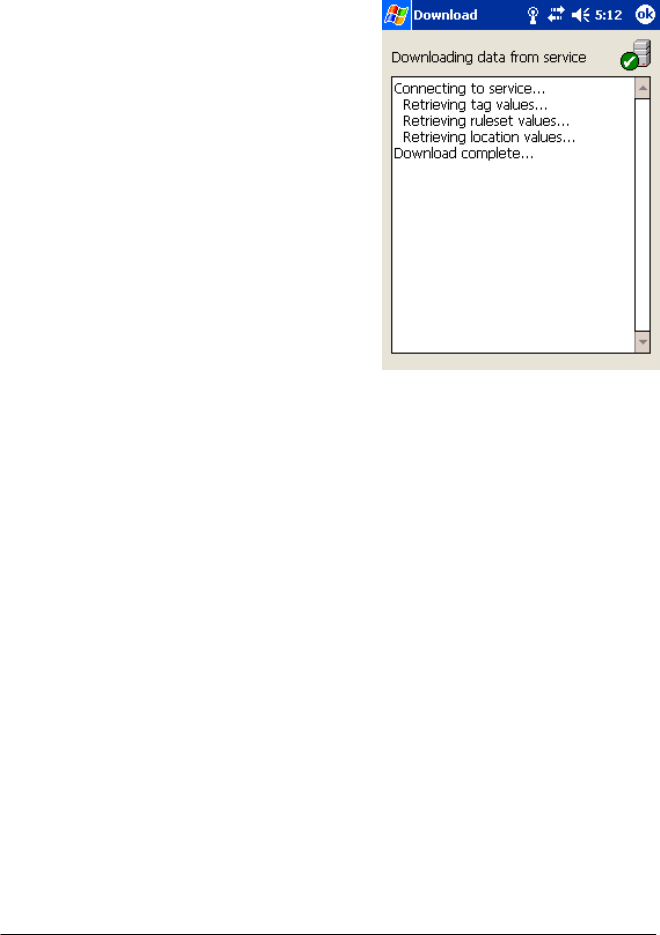
Downloading
All the tables required for operation of online
mode are retrieved from the Configurator
Service. A dialog is displayed that shows the
status of each table as it is downloaded.
To download from the PinPoint Mobile
Resource Manager:
1. Be sure the application is in
Working Online mode.
2. Click Download from the Main
Window.
• Notes
• The PinPoint Services host name and
port must be entered in the Settings
Services tab.
Download window
19
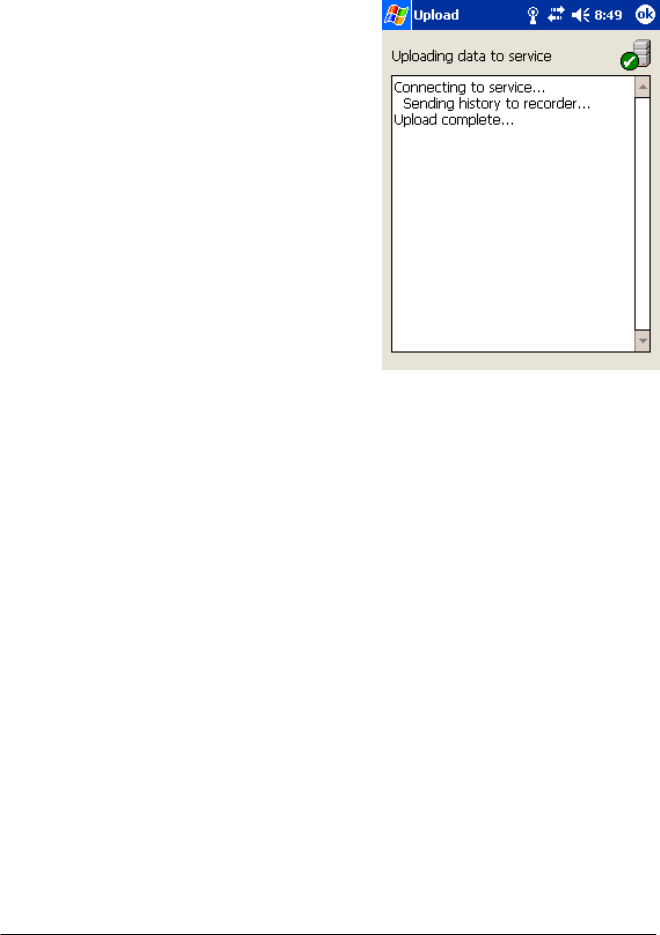
Uploading
Each time a tag is received a record is created
in the History table in the SQL CE Server
Seeker database. This record includes a
timestamp, tag id, and location (if online) and
other relevant information. To make this
information visible to the entire PinPoint
system the information must be uploaded to
the PinPoint Recorder Service. The Recorder
Service will then store it in the PPDataLog
database table.
To upload to the PinPoint Mobile Resource
Manager:
1. Be sure the application is in
Working Online mode.
2. Click Upload from the Main
Window.
• Notes
• The PinPoint Services host name and
port must be entered in the Settings
Services tab.
Upload window
20
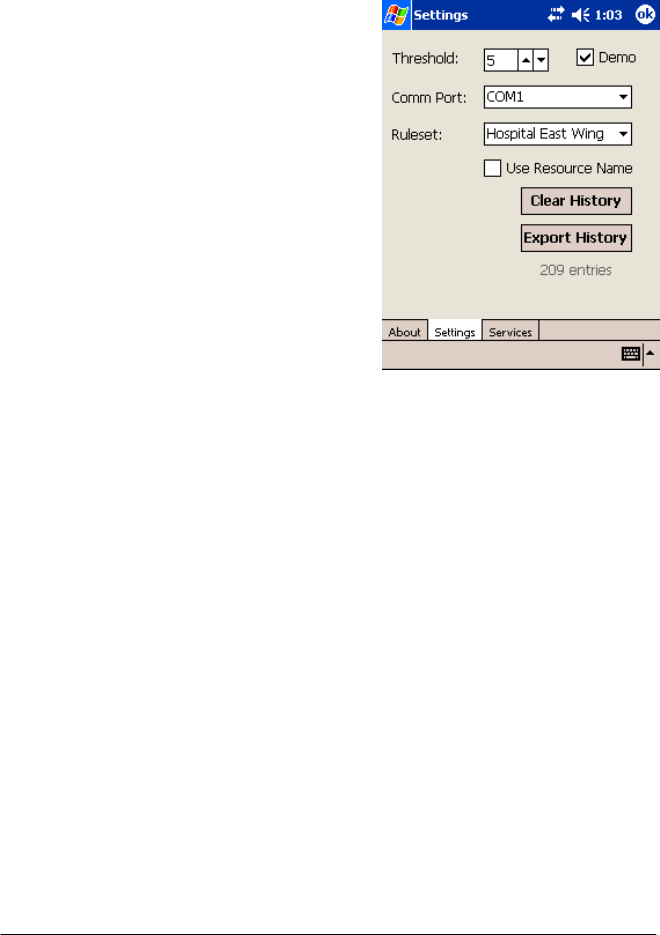
Additional Settings
You can specify the polling threshold value,
the communications port, and the locations
ruleset from this window.
Threshold – Indicates the minimum signal
strength required for a tag to be displayed in
the tag list.
Demo – When in demo mode each Find
operation will return a tag in the tag list. This
can be used for training and demonstration
purposes. Tags returned are always in
department one.
Comm Port – In cases were the application
does not automatically discover the compact
flash receiver card the comm port can be
manually selected.
Ruleset – Select the ruleset to be used to
retrieve locations from the PinPoint
Configurator Service. Once selected the user
must perform another download to retrieve
the locations.
Use Resource Name – When selected the
Find Tags window will display the Resource
name box instead of the department and tag
boxes. Resource Names come from the local
offline tags database created by the tag Entry
window.
Clear History – Clears the local storage
History table by deleting all of its entries.
Should be performed when record retrieval
becomes slow during history views.
Export History – Creates a CSV file of the
current history data. Displays a File Save
Dialog window.
Settings window
21
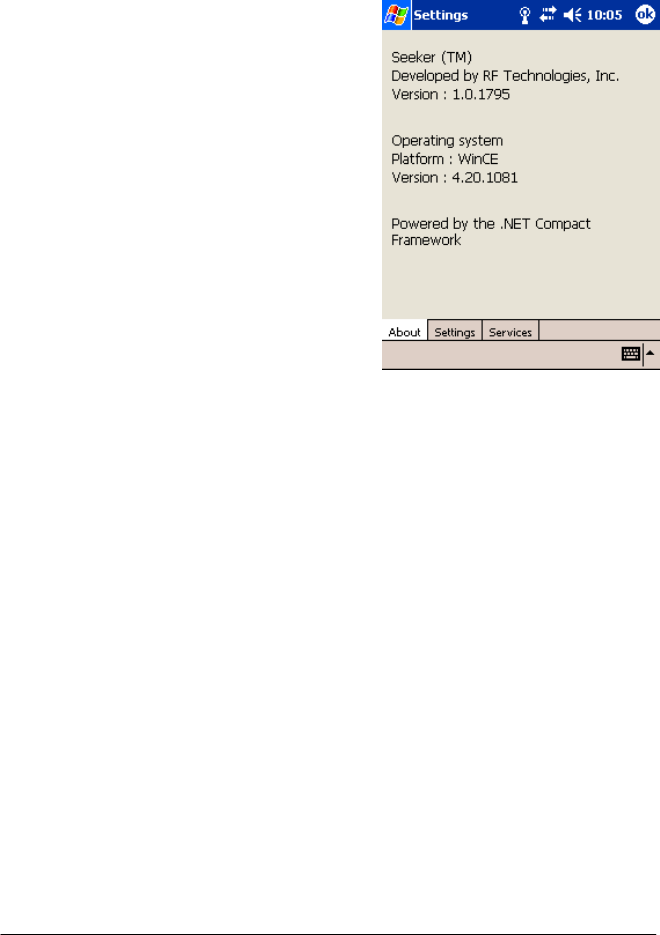
System Information
Displays the application version and
operating system version.
• Notes
• When calling technical support be sure
to have this information available.
Settings About
22

Frequently Asked Questions
What should I do if the Pocket PC application no longer responds?
Reboot the Pocket PC with a hard-reset. Typically a hard-reset can be
performed by pressing a recessed reset button on the Pocket PC. Consult
the Pocket PC user manual for the location of the reset button.
It is also possible that the battery is nearing expiration in the mobile
reader. Consult the Pocket PC user Manual for details on replacing or
recharging the battery.
The receiver card may have come loose in the socket. Remove and
reinsert the receiver card in the compact flash socket.
What should I do if the Pocket PC does not communicate with the MRM Services?
Make sure that the host name and port are properly entered on the Settings
Services tab. Make sure that the services are running on their respective
host machines.
What should I do if application starts reacting slowly?
The history table may be too large to provide adequate performance.
Check the number of entries in the history table by opening the Settings
window. If the number of entries is over 10,000 entries you may want to
Clear History.
How do I view and analyze data on another machine?
The history table can be exported to a Comma Separated Values (CSV)
file. This file can then be viewed by spreadsheet applications such as
Microsoft Excel. To export a CSV file open the Settings window. Click
Export History. A save file dialog will appear. Save the file to a known
location. Retrieve the file through the sync cradle and Microsoft Active-
Sync application explorer. See the Pocket PC documentation for details
on using Active-Sync.
How do I get the tag to sound or flash?
The beeper and light are controlled by checkboxes on the Find Tags
window. Make sure the correct selections are made before performing a
search.
23

How do I select the correct communications port?
In most cases the Seeker application will detect the Plug and Play ID of
the Receiver Card and configure it for the correct communications port.
If the application can not find the Receiver Card it is possible to manually
configure the communications port. Open the Settings window. In the
Communication Port box, select a comm port ID. Attempt to perform a
Find operation from the Find Tags window. Check the status of the
Receiver Card LED to determine if the application is communicating with
the card. Repeat until the correct port is identified.
Why do tags sometimes appear and disappear during consecutive searches from
the same area?
Certain tags may be just outside of the consistent read range of the mobile
reader. The environment may also affect the consistency of searches.
Metal walls and other construction materials can adversely affect the read
range of searches.
24

Specifications
Mobile Reader
Hand Held Pocket PC
Operating System: Pocket PC 2003
Recommended Processor: 400MHz (or higher)
Recommended Memory: 64MB Main Memory (or higher)
Must have at least one Compact Flash slot
Operating Time (Battery Life): See Pocket PC Manual
RF Transceiver Card
Interface: CompactFlash
Read Range: 0-500 Feet
Frequency: 433 MHz
Compliance: FCC Part 15
Capacity: 240 Dept. & 240 Tags
Total Capacity: 57,600 Tags
Software: PinPoint Seeker Application
Integrates with PinPoint Mobile Resource Manager Software version 3.5 or higher.
Tag
Dimensions: 1.9" x 1.38" x 0.7"
Battery Life: 2 Years
Power Source: 3.6V Lithium Battery
Frequency: 433 MHz
Compliance: FCC Part 15
Water Resistant
Audible Beeper and Light
Remote Programming of Department and Tag ID
25

Service and Repair
If you encounter problems with your equipment, please contact us for assistance.
Call 1-800-669-9946. If your equipment appears to be defective, a technician will
issue a Return Merchandise Authorization Number for prompt repair or
replacement.
To return merchandise
1. Obtain a Return Merchandise Authorization form by calling Customer
Service at 1-800-669-9946.
2. Include a copy of your invoice and a copy of the Return Merchandise
Authorization form in your shipment. Be sure to retain a copy of the
Return Merchandise Authorization form for your records.
3. Merchandise must be well-packaged, shipped prepaid, and insured for
your protection. Be sure to retain a copy of the tracking label from your
package.
4. Please write the Return Merchandise Authorization Number on the
outside of the package.
5. Ship to:
RF Technologies, Inc.
Attention: Repair Department
3125 North 126th Street
Brookfield, WI 53005
26

Warranty
RF Technologies, Inc. (herein referred to as “Seller”), warrants to the Buyer that
the RF Technologies, Inc. (Code Alert/Safe Place/Sensatec) System (herein
referred to as “Product”) will be free from defects in material and workmanship
for a period of one (1) year from date of sale and title, and will conform to the
Seller’s quotation.
Transmitter battery life is one (1) year or as quoted for sale. Battery is covered
by a limited warranty prorated over the life of the battery. The Battery warranty
only applies to battery life and does not include casings or clamps, which is one
(1) year as stated elsewhere in this warranty.
This warranty is a limited warranty and it is the only warranty made by Seller.
Seller’s sole obligation under this warranty shall be limited to repairing or
replacing any part, which, within one (1) year from the date of sale, is returned
to the factory, shipment prepaid, and upon examination by Seller, shall disclose
to have been defective. Alternatively, Seller may, at its sole option, instead elect
to refund the purchase price paid for the defective product. The criteria for all
testing shall be Seller’s applicable product specifications utilizing factory
specified calibration and test procedures and instruments. No allowance shall be
made for local repair bills or expenses without the prior written approval of
Seller. If Seller elects to replace any part, such replacement will not extend the
life of this warranty. Seller reserves the right to use refurbished parts for
warranty repairs or replacements. Buyer’s failure to pay the purchase price in
full by the due date will void all warranties for the product.
Warranty coverage does not include, and Seller disclaims any liability for, any
defect or performance deficiency (including failure to conform to product
descriptions or specifications) which results, in whole or in part, from (1)
improper storage, handling, maintenance or installation of the Product by Buyer,
its employees, agents, or contractors, (2) absence of any product, component, or
accessory recommended by Seller, but omitted at Buyer’s direction, including
but not limited to transmitters and banding materials not tested and approved,
(3) any design, specification, or instruction changed by Buyer, its employees,
agents, or contractors, (4) failure to comply with any applicable instructions or
recommendations of Seller, including installation procedures, (5) physical
damage occurring to transmitters or other components after receipt and
acceptance by buyer, or (6) any components, systems, process, or equipment not
sold or provided by Seller, or (7) acts of God, acts of civil or military authority,
fires, floods, strikes, or other labor disturbances, war, riot, or other causes
beyond the reasonable control of the Seller.
27

The preceding paragraphs set forth Buyer’s exclusive remedies and Seller’s sole
liability for claims based on the failure of the products to meet any warranty,
whether the claim is in contract, warranty, tort (including negligence and strict
liability), or otherwise, and however instituted, and upon the expiration of the
applicable warranty period of such liability shall terminate. IN NO EVENT
SHALL SELLER BE LIABLE FOR ANY DIRECT, INDIRECT, SPECIAL,
INCIDENTAL, OR CONSEQUENTIAL DAMAGES OF ANY KIND,
WHETHER OR NOT FORESEEABLE OR IN CONTEMPLATION OF THE
PARTIES, EVEN IF SELLER HAS BEEN ADVISED OF THE POSSIBILITY
OF SUCH DAMAGES.
THIS WARRANTY IS THE ONLY WARRANTY APPLICABLE TO
THE PRODUCT AND IS IN LIEU OF ANY OTHER WARRANTIES,
EXPRESSED OR IMPLIED, INCLUDING ANY IMPLIED WARRANTY OF
MERCHANTABILITY OR FITNESS FOR A PARTICULAR PURPOSE.
28

29 29